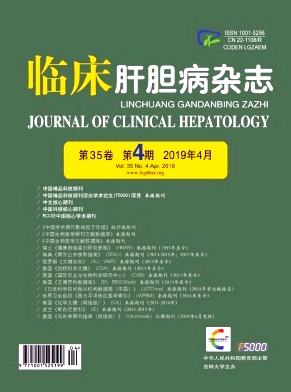|
[1]GARCIA-TSAO G, BOSCH J. Management of varices and variceal hemorrhage in cirrhosis[J]. N Engl J Med, 2011, 362 (9) :823-832.
|
|
[2]GARCIA-TSAO G, BOSCH J. Varices and variceal hemorrhage in cirrhosis:A new view of an old problem[J]. Clin Gastroenterol Hepatol, 2015, 13 (12) :2109-2117.
|
|
[3]BOSCH J, GARCIA-PAGAN JC. Prevention of variceal rebleeding[J]. Lancet, 2003, 361 (361) :952-954.
|
|
[4]LIN YQ, JIANG B, LI HQ, et al. Application of hepatic transit time in portal vein pressure assessment in patients with portal hypertension and esophago gastric varices[J]. J Jilin Univ:Med Edit, 2019, 45 (1) :170-174. (in Chinese) 林元强, 姜博, 李鹤群, 等.肝脏渡越时间在门静脉高压-食管胃底静脉曲张患者门静脉压力评估中的应用[J].吉林大学学报:医学版, 2019, 45 (1) :170-174.
|
|
[5]VOROBIOFF J, GROSZMANN RJ, PICABEA E, et al. Prognostic value of hepatic venous pressure gradient measurements in alcoholic cirrhosis:A 10-year prospective study[J]. Gastroenterology, 1996, 111 (3) :701-709.
|
|
[6]de FRACHIS R. Updating consensus in portal hypertension:Report of the Baveno III Consensus Workshop on definitions, methodology and therapeutic strategies in portal hypertension[J]. J Hepatol, 2000, 33 (5) :846-852.
|
|
[7]GROSZMANN RJ, BOSCH J, GRACE ND, et al. Hemodynamic events in a prospective randomized trial of propranolol versus placebo in the prevention of a first variceal hemorrhage[J]. Gastroenterology, 1990, 99 (5) :1401-1407.
|
|
[8]GARCIA-TSAO G, GROSZMANN RJ, FISHER RL, et al. Portal pressure, presence of gastroesophageal varices and variceal bleeding[J]. Hepatology, 1985, 5 (3) :419-424.
|
|
[9]DAMICO G, GARCIA-PAGAN JC, LUCA A, et al. Hepatic vein pressure gradient reduction and prevention of variceal bleeding in cirrhosis:A systematic review[J]. Gastroenterology, 2006, 131 (5) :1611-1624.
|
|
[10]ESCORELL A, BORDAS JM, CASTANEDA B, et al. Predictive value of the variceal pressure response to continued pharmacological therapy in patients with cirrhosis and portal hypertension[J]. Hepatology, 2000, 31 (5) :1061-1067.
|
|
[11]FEU F, GARCIA-PAGAN JC, BOSCH J, et al. Relation between portal pressure response to pharmacotherapy and risk of recurrent variceal haemorrhage in patients with cirrhosis[J]. Lancet, 1995, 346 (8982) :1056-1059.
|
|
[12]MERKEL C, BOLOGNESI M, BERZIGOTTI A, et al. Clinical significance of worsening portal hypertension during longterm medical treatment in patients with cirrhosis who had been classified as early good-responders on haemodynamic criteria[J]. J Hepatol, 2010, 52 (1) :45-53.
|
|
[13]TURNES J, GARCIA-PAGAN JC, ABRALDES JG, et al. Pharmacological reduction of portal pressure and long-term risk of first variceal bleeding in patients with cirrhosis[J]. Am J Gastroenterol, 2006, 101 (3) :506-512.
|
|
[14]de FRACHIS R. Revising consensus in portal hypertension:Report of the Baveno V consensus workshop on methodology of diagnosis and therapy in portal hypertension[J]. J Hepatol, 2010, 53 (3) :762-768.
|
|
[15]MERKEL C, BOLOGNESI M, SACERDOTI D, et al. Disagreement between acute and chronic haemodynamic effects of nadolol in cirrhosis:A pathophysiological interpretation[J].Aliment Pharmacol Ther, 2005, 22 (5) :433-439.
|
|
[16]VOROBIFF J, PICABEA E, VILLAVICENCIO R, et al. Acute and chronic hemodynamic effects of propranolol in unselected cirrhotic patients[J]. Hepatology, 1987, 7 (4) :648-653.
|
|
[17]ZHANG F, DUAN X, ZHANG M, et al. Influence of CYP2D6 andβ2-adrenergic receptor gene polymorphisms on the hemodynamic response to propranolol in Chinese Han patients with cirrhosis[J]. J Gastroenterol Hepatol, 2016, 31 (4) :829-834.
|
|
[18]BOSCH J, GARCIA-PAGAN JC, BERZIGOTTI A, et al. Measurement of portal pressure and its role in the management of chronic liver disease[J]. Semin Liver Dis, 2006, 26 (4) :348-362.
|
|
[19]DUAN XH, ZHUGE YZ, ZHANG F. Advances in study on preventive efficacy of non-selective beta-blockers in patients with esophageal gastric variceal bleeding[J]. Chin J Gastroenterol, 2015, 20 (10) :629-631. (in Chinese) 段旭红, 诸葛宇征, 张峰.非选择性β受体阻滞剂预防食管胃静脉曲张破裂出血的研究进展[J].胃肠病学, 2015, 20 (10) :629-631.
|
|
[20]ABRALDES JG, TARANTINO I, TURNES J, et al. Hemodynamic response to pharmacological treatment of portal hypertension and long-term prognosis of cirrhosis[J]. Hepatology, 2003, 37 (4) :902-908.
|
|
[21]MERKEL C, BOLOGNESI M, SACERDOTI D, et al. The hemodynamic response to medical treatment of portal hypertension as a predictor of clinical effectiveness in the primary prophylaxis of variceal bleeding in cirrhosis[J]. Hepatology, 2000, 32 (5) :930-934.
|
|
[22]GROSZMANN RJ, GARCIA-TSAO G, BOSCH J. et al. Betablockers to prevent gastroesophageal varices in patients with cirrhosis[J]. N Engl J Med, 2005, 353 (21) :2254-2261.
|
|
[23]SARIN SK, MISHRA SR, SHARNA P, et al. Early primary prophylaxis with beta-blockers does not prevent the growth of small esophageal varices in cirrhosis:A randomized controlled trial[J].Hepatol Int, 2013, 7 (1) :248-256.
|
|
[24]BHARDWAJ A, KEDARISETTY CK, VASHISHTHA C, et al. Carvedilol delays the progression of smal oesophageal varices in patients with cirrhosis:A randomised placebo-controlled trial[J].Gut, 2017, 66 (10) :1838-1843.
|
|
[25]REIBERGER T, ULBRICH G, FERLITSCH A, et al. Carvedilol for primary prophylaxis of variceal bleeding in cirrhotic patients with haemodynamic non-response to propranolol[J]. Gut, 2013, 62 (11) :1634-1641.
|
|
[26]BANARES R, MOITINHO E, PIQUERAS B, et al. Carvedilol, a new nonselective beta-blocker with intrinsic anti-alpha (1) -adrenergic activity, has a greater portal hypotensive effect than propranolol in patients with cirrhosis[J]. Hepatology, 1999, 30 (1) :79-83.
|
|
[27]GARCIA-TSAO G, GRACE ND, GROSMAN RJ, et al. Short-term effects of propranolol on portal venous-pressure[J].Hepatology, 1986, 6 (1) :101-106.
|
|
[28]DE-MADARIA E, PALAZON JM, HERNANDEZ FT, et al. Acute and chronic hemodynamic changes after propranolol in patients with cirrhosis under primary and secondary prophylaxis of variceal bleeding:A pilot study[J]. Eur J Gastroenterol Hepatol, 2010, 22 (5) :507-512.
|
|
[29]LA MURA V, ABRALDES JD, RAFFA S, et al. Prognostic value of acute hemodynamic response to i. v. propranolol in patients with cirrhosis and portal hypertension[J]. J Hepatol, 2009, 51 (2) :279-287.
|
|
[30]LIN FY, HUANG H, LU ML. Research advances in prognositic factors for patients with esophagogastirc variceal bleeding[J]. J Clin Hepatol, 2018, 34 (11) :2428-2432. (in Chinese) 林凡榆, 黄华, 路明亮.食管胃静脉曲张破裂出血预后相关因素的研究进展[J].临床肝胆病杂志, 2018, 34 (11) :2428-2432.
|









 本站查看
本站查看




 DownLoad:
DownLoad: